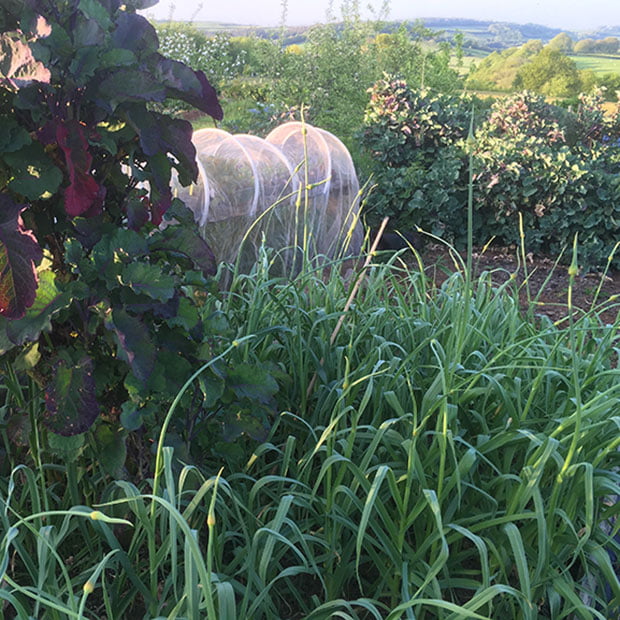Poireau perpétuel perennial leek potted plant
£6.50
POTTED PLANT WITH SMALL LEEKS ( MINIMUM 5 PER POT)
A fantastic perennial leek that grows into a good sized leek with excellent pest resistance. Larger than a Babington leek. Harvest by cutting at ground level every year in spring/summer and watch your leeks emerge again over the winter. These leeks were sown in spring 2023 and can be planted out now.
Awaiting Re-stock
We can email you when it's back ...
Description
Poireau perpétuel ( Allium ampeloprasum var bulbiferum) are one of the tastiest, low maintenance and easy to grow perennial vegetables providing a yearly harvest of slender leeks with a hint of garlic. Poireau perpétuel leeks can be harvested by cutting the leek at the base and leaving the bulb in the ground to re-grow. Depending on your location and climate leeks can emerge from early winter through to early spring. Very hardy. Leeks will go dormant in the hotter months and re-emerge in the autumn for their first two years, this is part of their natural life cycle. Leave some unharvested and allow them to flower and produce a head of bulbils, which you can collect to propagate more plants
About
Poireau perpétuel perennial leek (Allium Ampeloprasum) is one of the tastiest and easy to grow perennial vegetables. Poireau perpétuel is similar to a Babington but produces a larger and thicker leek. Our original bulbils came to us in 2016 from Anni Kelsey ( author of ‘Edible Perennial Gardening, Growing Successful Polycultures in Small Spaces’.) Although they are widely grown in France, they are not easy to find in the UK so we are really pleased to offer them. They are extremely low maintenance and ideal for polyculture spaces as they will thrive between other plants and can tolerate a range of soils and positions.
Grow
Perennial leeks can be planted out during winter and spring. You can separate them and give them 10-15cm spacing, plant in a sunny spot. For the first couple of years leeks will be small, but their underground bulbs will still be developing during this time. Leeks will really begin to bulk up from their third year onwards and can grow into very good size leeks similar to a standard garden leek. Remember also, that in their first two years they tend to go dormant in the heat of summer and re-emerge in with the dampness of winter. The bulb part stays alive underground waiting for the right conditions to sprout again, so they haven’t died, they just retreat underground whilst its really hot. From their third year leeks will flower and produce heads of bulbils.
Harvest
Simply cut the leeks at the base and leave the bulbs in the ground to re-grow. Harvesting time is usually March to June.
Propagating more plants
Poireau perpétuel perennial leeks are so tasty that you will want to harvest them all, but if you want to increase your stock quickly you need to let some of them flower. The leeks will throw up a very tall stem around July time with very attractive purple flowers. These in turn go on to produce a head of bulbils, each bulbil producing a new leek. The head will naturally bend and plant itself or you can gather bulbils and separate them when the cases are papery and sow in a new spot. As the plants mature, they produce a very large underground bulb with a cluster of ‘mini bulbs’ or offsets which will form clumps of new growth above ground. You can lift and separate and move bulbs around when they are in their dormant stage. You will find leeks popping up in strange places as bulbils sometimes get flung a distance, but it is exciting when that happens! It takes patience to establish a Poireau perpétuel colony, but well worth it and you will have them forever.
Life Cycle
The life cycle of the leeks is: Emerge in early winter, harvesting period March to June, flowers emerge July to August ( from plants that have not been cut for harvesting), heads of bulbils can be collected in August, plants then go into a period of dormancy and all top growth will disappear until moisture returns. As each year passes the underground bulbs become larger. Timing of growth/flowering cycle may vary according to your location and temperature. Sometimes the heads of bulbils will not form until the second year when the plants have become more established.
Cooking and eating
Poireau perpétuel flowers, stems, bulbs and bulbils are all edible. The leeks have a deep savoury taste and make the most delicious base for soups, are great in omelettes, or just simply sautéed in a pan. They have a garlicky hit too which just adds to their many culinary uses.








